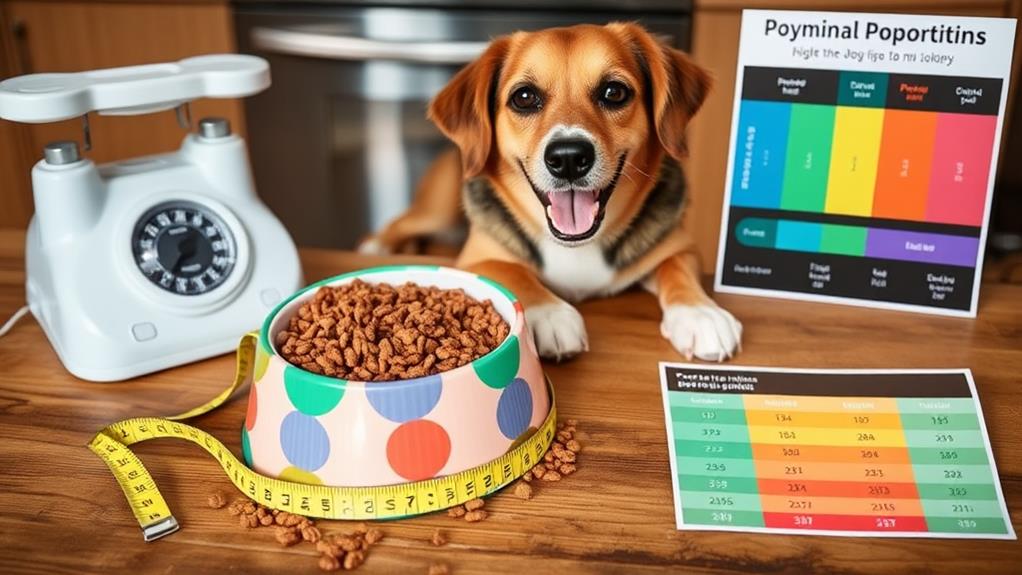Controlling your dog's portion sizes is vital for their health and preventing obesity. Start by evaluating their age, breed, and activity level to determine ideal portions. Use high-quality dog food that meets their nutritional needs, and measure it accurately with a digital scale or measuring cups. Monitor your dog's weight weekly and adjust portions gradually based on their condition. Regular feeding schedules help regulate appetite, while incorporating physical activity supports a balanced lifestyle. If your pup needs to lose weight, consult a vet for specific calorie targets. There's a lot more to uncover about perfect feeding practices!
Importance of Portion Control
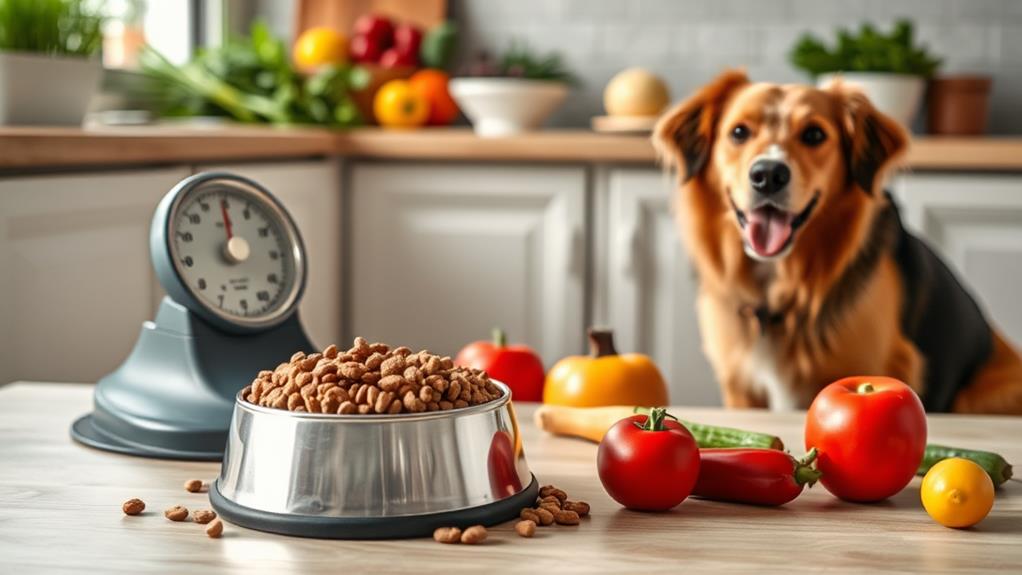
Portion control is crucial for maintaining your dog's overall health and well-being. When you feed your dog the right amount, you help prevent obesity, which can lead to serious health issues like diabetes, heart disease, and joint problems. Overfeeding not only affects your dog's weight but can also result in nutritional imbalances. By monitoring portion sizes, you guarantee your furry friend gets the right nutrients without excess calories.
It's important to recognize that different breeds, ages, and activity levels require different portions. You might think that a little extra food won't hurt, but those extra calories add up quickly. Pay attention to your dog's body condition and adjust portions accordingly. If you're unsure how much to feed, consult your veterinarian for tailored advice.
Additionally, establish a consistent feeding schedule. This helps regulate your dog's appetite and digestion, making it easier for you to manage their portions. Don't forget to factor in treats and snacks, as they contribute to your dog's daily caloric intake. By practicing portion control, you promote a healthier lifestyle for your pet and can enjoy many happy years together.
Understanding Canine Nutritional Needs
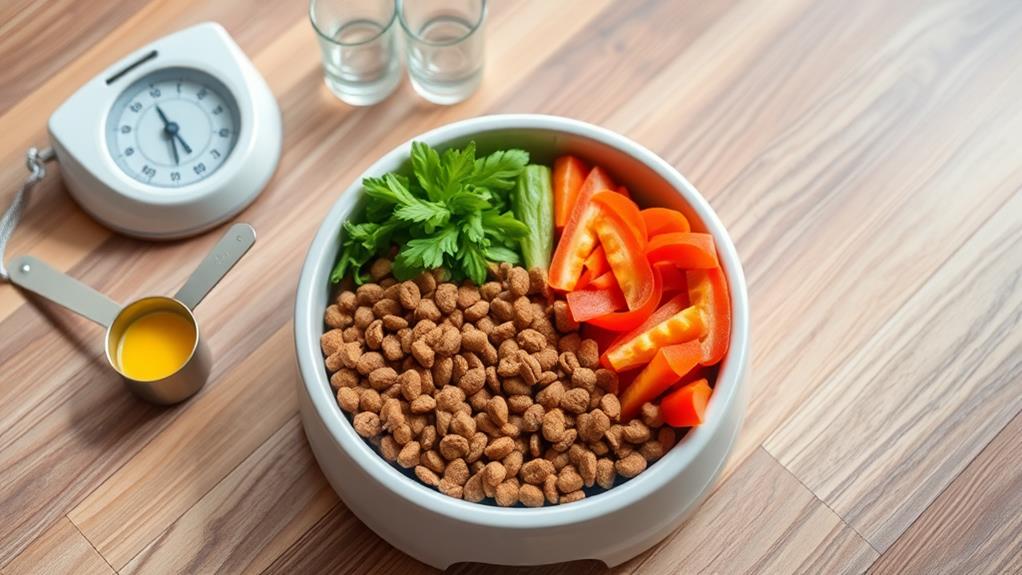
Understanding your dog's nutritional needs is essential for providing the right balance of nutrients and maintaining their health. Dogs require a mix of proteins, fats, carbohydrates, vitamins, and minerals to thrive. Each nutrient plays a specific role; for instance, proteins support muscle development and repair, while fats provide energy and help with nutrient absorption.
When choosing a dog food, look for high-quality ingredients. The protein source should be clearly identified, such as chicken or beef, and it should be the primary ingredient. Carbohydrates, like sweet potatoes or brown rice, can provide energy but should be balanced with protein and fats. Avoid fillers like corn and soy that offer little nutritional value.
Additionally, consider your dog's life stage—puppies, adults, and seniors all have different nutritional needs. Puppies need higher protein for growth, while older dogs may benefit from reduced calories and added fiber to support digestion.
Calculating Ideal Dog Weight
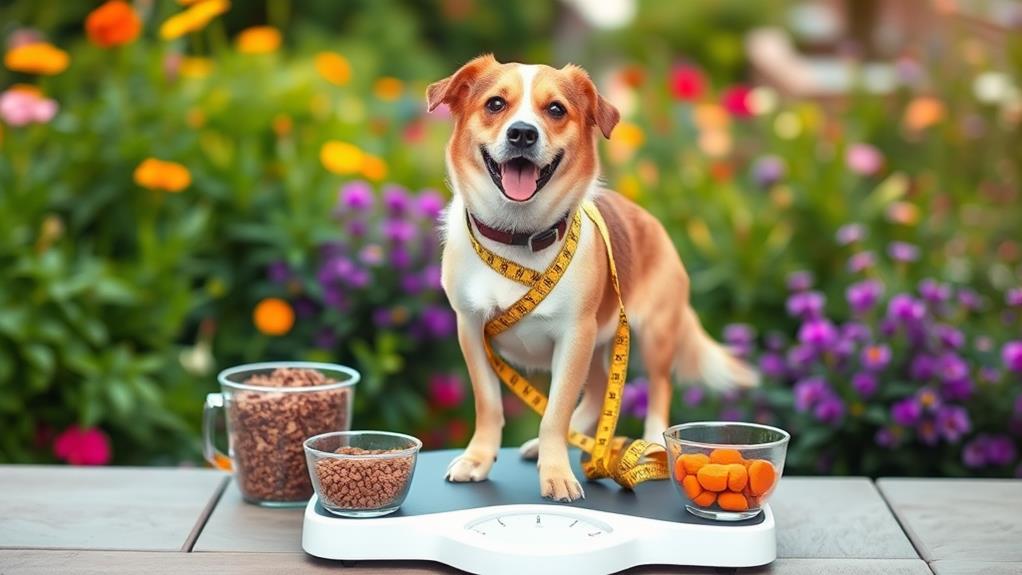
To safeguard your dog maintains a healthy weight, it's crucial to calculate their ideal weight based on factors like breed, age, and activity level. Start by understanding the typical weight range for your dog's breed. This information can usually be found in breed-specific resources or your vet's office.
Next, consider the following factors to refine your calculations:
- Age: Puppies and seniors may have different ideal weights compared to adults.
- Size: Small, medium, and large breeds have distinct weight norms.
- Body Condition: Assess your dog's body condition score (BCS) for a more tailored approach.
- Health Issues: Certain medical conditions may affect your dog's ideal weight.
- Veterinary Guidance: Always consult with your vet for personalized recommendations.
Once you gather this information, you can better determine your dog's ideal weight. Remember, maintaining a healthy weight not only keeps your dog fit but also reduces the risk of health issues down the line. Regularly re-evaluating your dog's weight will help you make necessary adjustments to their diet and exercise routines to keep them happy and healthy.
Assessing Dog Activity Levels

Dog activity levels play an essential role in determining their dietary needs and overall health. To determine your dog's activity level, consider their daily routine. Are they a couch potato or a high-energy explorer? Dogs generally fall into three categories: low, moderate, and high activity.
Low-activity dogs typically lead a more sedentary lifestyle, needing less exercise. This could include older dogs or those with health issues.
Moderate-activity dogs enjoy regular walks and playtime but don't require excessive exercise.
High-activity dogs, like working breeds, thrive on vigorous daily workouts and mental stimulation.
Observe your dog's behavior. If they seem restless or overly energetic, they might need more activity. On the other hand, if they're lethargic or uninterested in play, it may indicate they're getting too much exercise or not enough stimulation.
Keep track of their daily activities—walking, playing, or engaging in training. This helps identify their energy needs and how much food they require. By accurately evaluating your dog's activity level, you can make informed decisions to support a balanced diet that aligns with their lifestyle.
Choosing the Right Dog Food
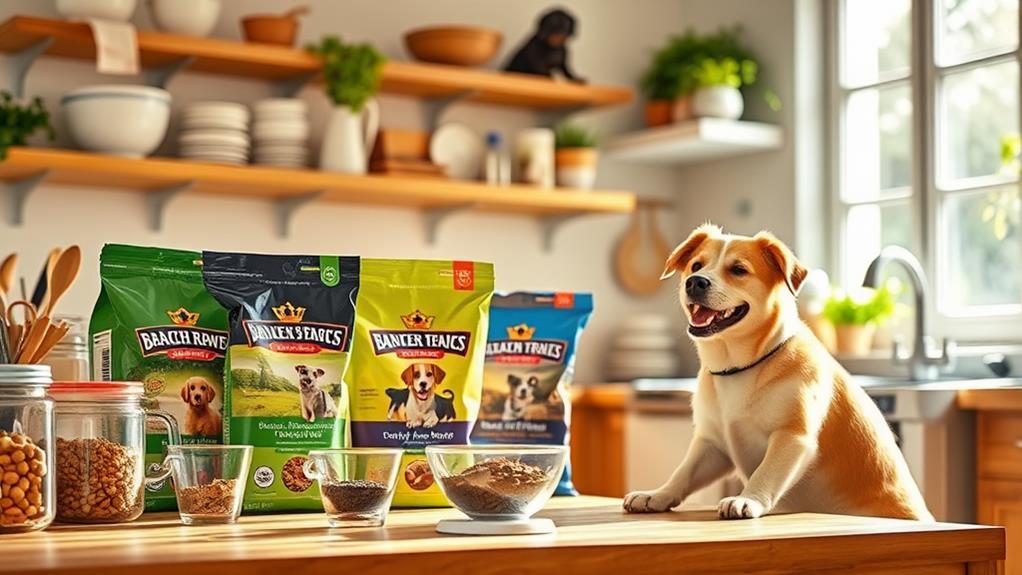
When selecting the right dog food, it's crucial to take into account your dog's specific needs, including their age, weight, and activity level. Different dogs require different nutrients, so understanding what your pup needs helps you make the best choice.
Consider these factors when choosing dog food:
- Life Stage: Puppies need more protein and calories, while seniors require fewer calories but more fiber.
- Size and Breed: Larger breeds may benefit from kibble designed for their size, while small breeds might need food that's easier to chew.
- Health Conditions: If your dog has allergies or specific health issues, look for special formulas that address those needs.
- Ingredient Quality: Choose foods with high-quality ingredients, prioritizing real meat and whole grains over fillers.
- Brand Reputation: Research brands and read reviews to ensure you're selecting a reputable company committed to quality.
Measuring Food Portions Accurately
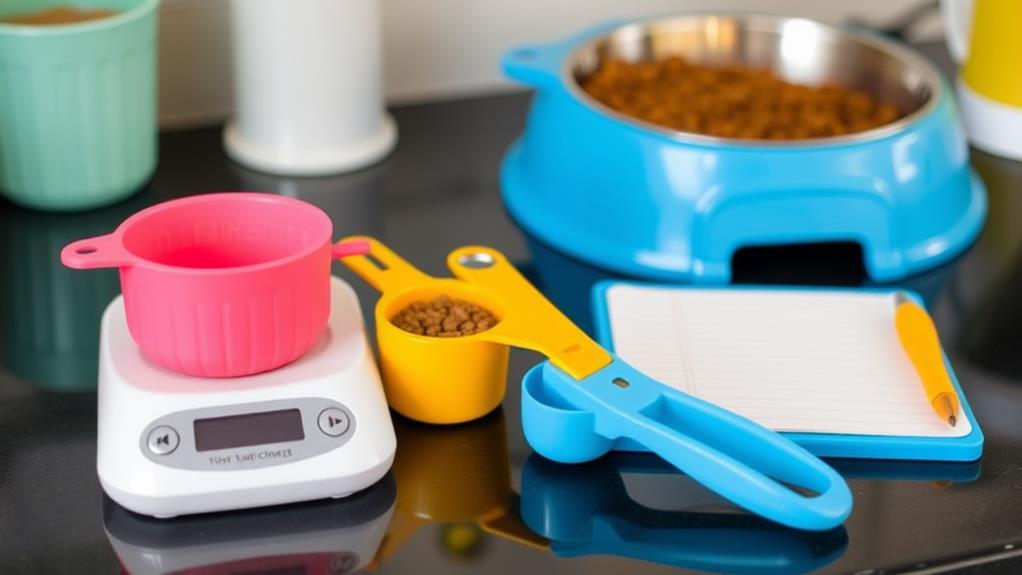
Selecting the right dog food is just the beginning; getting the portions right is equally important. Accurate measuring guarantees your dog receives the right nutrients without overfeeding or underfeeding. Here's how to make it easier for you:
- Use a Scale: A digital kitchen scale is one of the most effective tools for accuracy. Weigh your dog's food according to the serving size recommended on the packaging.
- Measuring Cups: If you don't have a scale, measuring cups work too. Just make sure you're using the right cup size for dry food versus wet food.
- Consistency is Key: Always measure food at the same time of day, and use the same method each time to maintain consistency in portions.
Here's a simple reference table to help you visualize the portion sizes based on your dog's weight:
| Dog Weight (lbs) | Daily Food Portion (cups) |
|---|---|
| 5-10 | 1/2 – 1 |
| 11-20 | 1 – 1 3/4 |
| 21-40 | 1 3/4 – 3 |
| 41-60 | 3 – 4 |
| 61+ | 4 – 5+ |
Adjusting Portions for Weight Loss
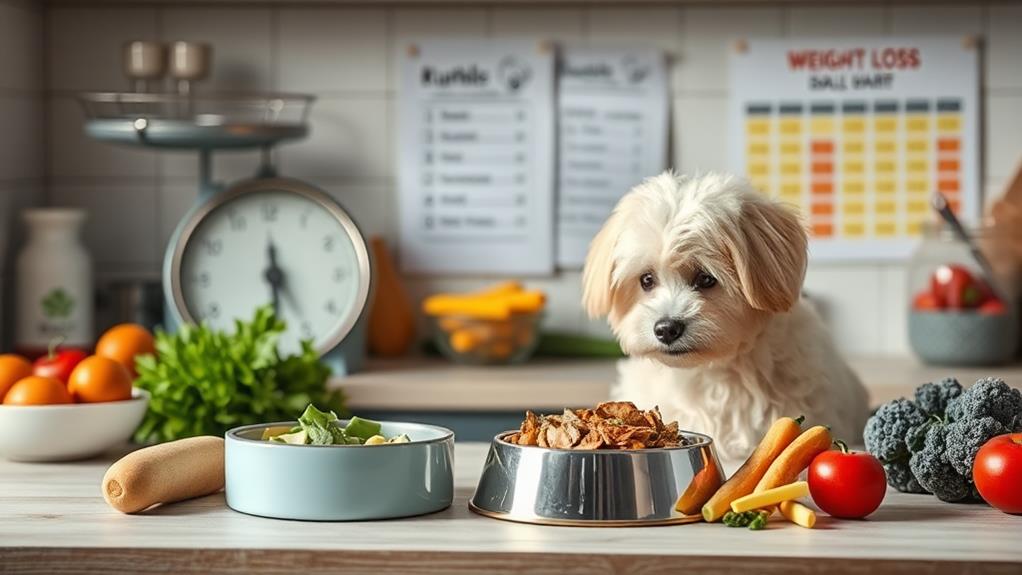
Achieving healthy weight loss for your dog requires careful adjustments to their food portions. Start by evaluating your dog's current weight and target weight to establish a clear goal. Once you have that in mind, you can begin to modify their food intake.
Here are some tips to help you adjust portions effectively:
- Consult your vet: Always get professional advice to determine the right calorie intake for weight loss.
- Gradual reduction: Decrease their daily food portions slowly to avoid shocking their system.
- Measure accurately: Use a scale or measuring cup to confirm precise portions.
- Incorporate low-calorie treats: Replace high-calorie snacks with healthier options like carrots or green beans.
- Monitor feeding times: Stick to regular feeding schedules to help regulate your dog's appetite.
As you make these changes, keep an eye on your dog's response. Weight loss should be gradual and steady, as rapid weight loss can lead to health issues. By following these guidelines, you'll set your dog on a path toward a healthier weight and a happier life.
Monitoring Your Dog's Progress
Monitoring your dog's progress is essential to guarantee they're on track with their weight loss journey. Regularly weighing your pup is a critical part of this process. Ideally, you should weigh them weekly to observe any changes in their weight. Use a reliable scale, and keep a record of their weight over time to spot trends.
In addition to weighing, pay attention to your dog's body condition score (BCS). This system helps assess whether your dog is underweight, ideal, or overweight. You can find BCS charts online to guide you in evaluating your dog's body shape and fat coverage.
Keep an eye on your dog's energy levels, too. If they seem more active and playful, it's a good sign that your weight management strategy is working.
If you notice minimal weight loss or even weight gain, it might be time to re-evaluate their portion sizes or the type of food you're providing. Consult your veterinarian if you're unsure about the right adjustments. By actively monitoring your dog's progress, you can ascertain they're healthy and happy as they work towards their ideal weight.
Frequently Asked Questions
How Often Should I Feed My Dog Each Day?
You should feed your dog two to three times a day, depending on their age, size, and activity level. Splitting their meals helps with digestion and keeps their energy steady throughout the day.
Can I Mix Dry and Wet Food for My Dog?
Sure, you can mix dry and wet food for your dog! It adds flavor and variety, but just be mindful of overall calorie intake to prevent overfeeding. Balance is key for a healthy diet.
Are Treats Included in Daily Portion Calculations?
Yes, treats count towards your dog's daily food intake. To maintain a balanced diet, include treats in their overall portion calculations. Remember, moderation is key to keeping your pup healthy and happy!
What Signs Indicate My Dog Is Over or Underweight?
You might think your pup's just fluffy, but feel for those ribs. If you can't, it's time to rethink meals. A tucked tummy or difficulty moving can signal your dog's tipping the scales.
Should Portion Sizes Change With My Dog's Age?
Yes, portion sizes should change as your dog ages. Puppies need more calories for growth, while senior dogs require fewer to maintain a healthy weight. Adjust their food accordingly to support their changing needs.
Conclusion
In the quest for your dog's health, remember that portion control is the golden key to a happier, longer life—think of it as a canine version of Goldilocks, finding that "just right" balance. By understanding your furry friend's nutritional needs and adjusting portions based on activity levels, you'll guarantee they thrive. Keep measuring, monitoring, and adjusting, and your dog will thank you with wagging tails and joyful barks. After all, a healthy pup is a happy pup!

